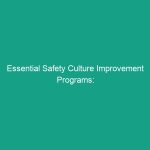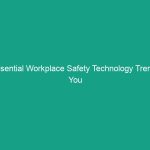Good Morning Team!
Today, we’re going to talk about an essential but often overlooked aspect of Workplace Safety: Essential Clearance Zones Around Machinery: Maintaining Safe Distances. Understanding this topic is crucial for not only your Safety but also for the Safety of your colleagues. Proper clearance zones can prevent accidents, injuries, and even fatalities. So, let’s dive into why maintaining these safe distances is vital in our daily operations.
Understanding Essential Clearance Zones
Essential clearance zones refer to the safe areas surrounding machinery where employees must maintain a safe distance to avoid Hazards. These zones are designed to protect workers from potential accidents, such as being struck by moving equipment, caught in machinery, or exposed to other risks. Understanding these zones helps to create a safer working Environment and ensures that everyone can perform their tasks without the worry of injury.
Many people think that clearance zones are merely guidelines, but they’re critical Safety Measures. Failure to adhere to these zones can lead to serious consequences, including accidents that could have been easily prevented.
Key Hazards, Risks, and Safety Considerations
When we talk about essential clearance zones, it’s vital to recognize the specific hazards associated with working near machinery. Here are some common hazards:
- Moving Parts: Machinery often has moving parts that can cause severe injuries if workers get too close.
- Falling Objects: Tools or materials can fall from machinery, posing a risk to anyone within the clearance zone.
- Noise Exposure: Prolonged exposure to high noise levels from machinery can lead to hearing loss.
- Electrical Hazards: Machinery can have exposed wires or components that pose an electrical risk if approached too closely.
The real-world consequences of ignoring these clearance zones can be devastating. Injuries can range from minor cuts and bruises to life-altering accidents. It’s essential to understand that maintaining these distances is not just a guideline but a critical safety requirement.
Best Practices, Procedures, & Actionable Advice
To maintain safe distances around machinery, here are some Best Practices and Procedures you should follow:
- Know Your Clearance Zones: Familiarize yourself with the designated clearance zones for each piece of machinery. These are often marked with signage.
- Maintain a Safe Distance: Always keep a safe distance from machinery while it’s in Operation. If unsure, consult your supervisor.
- Wear Appropriate PPE: Personal Protective Equipment (PPE) should be worn at all times when working near machinery. This includes hard hats, gloves, and Safety Goggles.
- Stay Alert: Always be aware of your surroundings and the operations occurring around you.
- Report Hazards: If you see any unsafe conditions or if machinery is not operating correctly, report it immediately.
Let’s look at a brief real-world incident to further illustrate these practices: A worker once sustained injuries after stepping too close to a running conveyor belt. The worker was not aware of the clearance zone and didn’t see the warning signs. This incident could have been avoided if the worker had followed the clear guidelines established by the company.
Regulations, Standards, and Compliance
Compliance with safety Regulations is not just a best practice; it’s a legal requirement. Organizations such as OSHA (Occupational Safety and Health Administration) provide guidelines on maintaining safe distances around machinery. These regulations are designed to protect employees and ensure that the workplace is free from hazards.
Understanding these Standards is essential. When we comply with safety regulations, we not only protect ourselves but also our colleagues. Non-compliance can lead to severe penalties and increased risks of accidents.
Employee Engagement & Discussion
Now, let’s open the floor for some discussion. I’d like you to think about the following questions:
- What safety challenges have you encountered related to clearance zones?
- Can you share an experience where maintaining a safe distance prevented an accident?
Your input is invaluable. Sharing experiences helps us learn from one another and fosters a culture of safety within our team.
Conclusion & Key Takeaways
To wrap up, understanding and maintaining essential clearance zones around machinery is vital for Workplace Safety. Remember these key takeaways:
- Familiarize yourself with the clearance zones for each piece of machinery.
- Always maintain a safe distance from operating machinery.
- Wear appropriate PPE when working near machines.
- Be proactive in reporting any hazards or unsafe conditions.
Thank you for your attention today, and for your commitment to safety. Let’s all prioritize these practices to ensure we work in a safe and healthy environment. Remember, safety is everyone’s responsibility!


